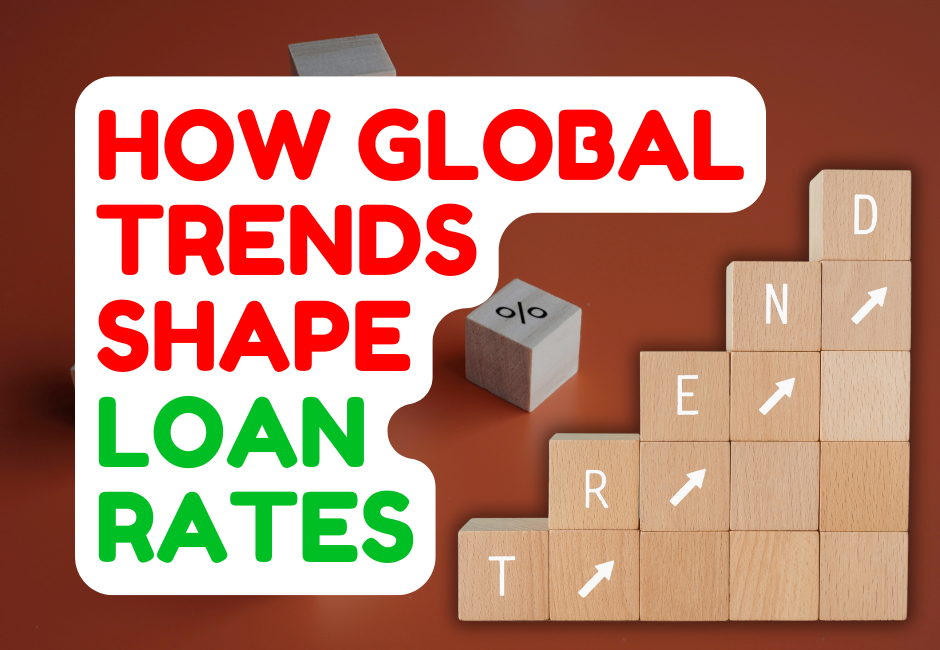
How Global Economic Trends Affect Home Loan Rates: A Data-Driven Analysis
How Global Economic Trends Affect Home Loan Rates: A Data-Driven Analysis
The Connection Between the Global Economy and Home Loan Rates
Home loan rates are shaped by far more than local market dynamics—they are influenced by powerful global economic forces. Whether you are a first-time buyer, property investor, or looking to refinance, understanding how global trends affect mortgage rates can help you make smarter and more cost-effective decisions.
From inflation spikes and central bank moves to shifts in global financial markets, these factors have a direct impact on how much you pay on your home loan over time. Ignoring these trends can leave you exposed to unexpected rate hikes and rising repayments.
This article covers:
- The global economic factors that influence home loan rates
- A data-driven look at how rates have responded to past economic shifts
- Practical strategies to adjust your mortgage approach in light of global changes
- What borrowers can expect in the future
By the end, you will have the insights to navigate rate movements confidently, whether you are securing your first mortgage or fine-tuning your investment strategy.
Key Global Economic Factors Driving Home Loan Rates
Several global indicators play a major role in shaping mortgage interest rates. Keeping an eye on these can help you time your borrowing decisions more strategically.
1. Inflation and Its Impact on Home Loan Rates
Inflation measures how quickly the cost of goods and services rises. When inflation surges, central banks often raise interest rates to cool economic activity and prevent the economy from overheating.
- High inflation → higher interest rates → more expensive mortgage repayments
- Low inflation → lower interest rates → cheaper borrowing
For example, during the 2021–2023 inflation surge, global inflation exceeded 7%, forcing central banks such as the Reserve Bank of Australia (RBA) to hike rates rapidly. This pushed mortgage rates from under 3% to over 6%, sharply increasing borrowing costs.
Borrower impact:
On a $600,000 loan at 3%, monthly repayments were around AUD 2,530. At 6%, repayments soared to AUD 3,600—a 43% increase.
2. Central Bank Policies and Interest Rate Decisions
Central banks like the RBA, the US Federal Reserve, and the European Central Bank set benchmark interest rates that influence borrowing costs worldwide.
- When central banks raise rates, commercial lenders pass on the cost, pushing mortgage rates higher.
- When central banks cut rates, lenders reduce rates, making borrowing cheaper.
During the COVID-19 pandemic, central banks slashed rates to historic lows (0.10% in Australia), triggering a property boom. But as inflation surged in 2022, they raised rates aggressively, making loans more expensive.
3. Global Financial Market Trends
Events such as stock market crashes, banking crises, or economic slowdowns often force central banks to adjust interest rates.
- 2008 Global Financial Crisis: Led to sharp rate cuts and record-low mortgage rates.
- Post-COVID recovery: Sparked inflation and triggered aggressive rate hikes.
4. Exchange Rates and Foreign Investment
A weak national currency (such as a falling Australian dollar) has two key effects:
- Imported goods become more expensive, driving inflation higher.
- International investors often increase their buying activity in Australia, pushing up property demand and potentially mortgage rates.
When the Australian dollar weakens against the US dollar, for example, global investors may pour more money into the Australian market, adding pressure to home loan costs.
Data Analysis: How Rates Shift During Economic Cycles
1. Interest Rates in Booms vs. Recessions
| Economic Period | Interest Rate Trend | Impact on Home Loans |
| 2008–2013 (Post-GFC) | Falling (4–5%) | Cheaper borrowing, property market rebound |
| 2014–2019 (Economic Growth) | Stable to rising (5–6%) | Slight decline in affordability |
| 2020–2021 (COVID Stimulus) | Record low (2–3%) | Cheap loans, major property boom |
| 2022–2023 (Post-pandemic) | Rapid rise (6–7%) | High borrowing costs, cooling housing demand |
2. Global Rate Hikes (2022–2023)
| Country | Rate Before 2022 | Peak Rate 2023 | % Increase |
| Australia (RBA) | 0.10% | 4.35% | 4,250% |
| USA (Federal Reserve) | 0.25% | 5.50% | 2,100% |
| UK (Bank of England) | 0.10% | 5.25% | 5,150% |
For homeowners, this translated to mortgage repayments doubling or tripling in some cases.
How to Adjust Your Home Loan Strategy to Global Shifts
1. Choose Between Fixed and Variable Rates Wisely
- Rising rates: Consider locking in a fixed rate for repayment certainty.
- Falling rates: A variable rate may allow you to benefit from rate cuts.
- Split loans: Combine fixed and variable components for balance.
2. Monitor Inflation and Central Bank Signals
Stay informed about inflation trends and rate decisions.
- If inflation declines, rates may stabilise or fall, improving borrowing conditions.
- If inflation persists, expect more rate hikes.
3. Strengthen Your Loan Profile
- Improve your credit score for better rates.
- Save a larger deposit to lower your loan-to-value ratio (LVR).
- Use offset accounts to reduce interest without locking money into repayments.
4. Plan for Market Cycles
- When rates are high: Consider waiting for possible cuts before locking in long-term fixed rates.
- When rates are low: Take advantage of fixed rates for long-term savings.
Outlook for Home Loan Rates: What Borrowers Should Expect
The future of home loan rates depends on global dynamics:
- If inflation continues to ease, central banks may pause or lower rates, reducing borrowing costs.
- If economic growth slows, rates could be cut to stimulate spending.
- If global disruptions (like energy shocks or geopolitical tension) persist, inflation may stay high, keeping rates elevated.
For borrowers, the best strategy is to stay alert, compare rates regularly, and adjust mortgage plans as global conditions shift.




